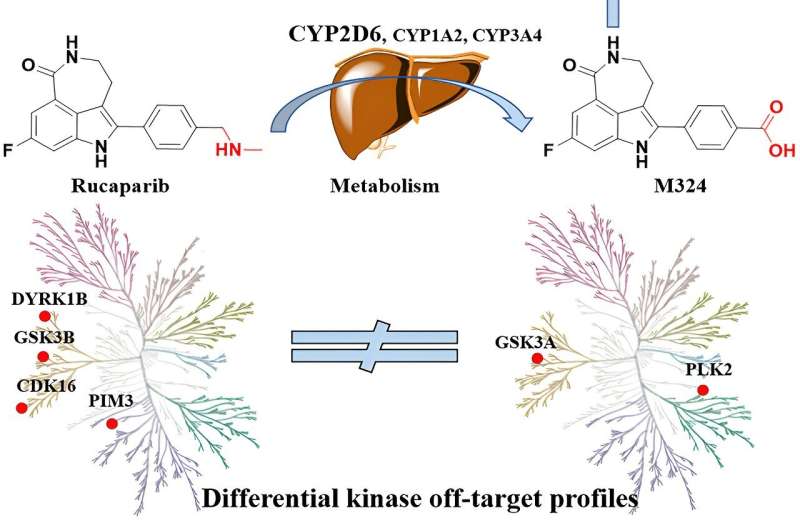This article has been reviewed according to Science X's editorial process and policies. Editors have highlighted the following attributes while ensuring the content's credibility:
fact-checked
trusted source
proofread
An anticancer drug opens a new path for the treatment of Parkinson's

Once they enter the body, drugs, apart from carrying out their therapeutic function, are biochemically transformed by the action of the metabolic machinery, a process that facilitates their expulsion. This biotransformation results in a gradual disappearance of the drug, which is converted into its metabolites.
These, in turn, can reach high concentrations in the body and also show a biological activity that may be different from that of the original drug. That is, the metabolites and the drug coexist in the body and can cause effects different from those obtained with the individual molecules.
This is the case of Rucaparib, a drug used in chemotherapy for ovarian cancer, breast cancer, and, more recently, prostate cancer, and its metabolite, the M324 molecule. Rucaparib is part of a group of drugs designed to treat several types of cancers that show alterations in DNA repair. Specifically, they are inhibitors of the PARP1 enzyme, involved precisely in the process of repairing mutations in the genetic material.
A study led by researchers Albert A. Antolin, from the Oncobell program of the Bellvitge Biomedical Research Institute (IDIBELL) and ProCure of the Catalan Institute of Oncology (ICO), and Amadeu Llebaria, from the Institute of Advanced Chemistry of Catalonia (IQAC-CSIC ), has shown that Rucaparib and its main metabolite M324 exhibit differential activities.
Published in the journal Cell Chemical Biology, the paper has analyzed Rucaparib and M324, making a computational prediction of the metabolite's activity. The article describes the synthesis of M324 and its biological assay, demonstrating that the drug and its metabolite have differentiated activities and act synergistically in some prostate cancer cell lines.
Surprisingly, M324 reduces the accumulation of the protein α-synuclein (an important component of Lewy bodies) in neurons derived from patients with Parkinson's, a neurodegenerative disease characterized by a movement disorder, and in which neurons do not produce sufficient amounts of the neurotransmitter dopamine.
Specifically, the synergy demonstrated between Rucaparib and M324 in prostate cancer cell lines could have an impact on clinical trials for advanced stages of this type of cancer. On the other hand, the fact that M324 is capable of reducing the abnormal accumulation of α-synuclein in neurons derived from stem cells of a Parkinson's patient highlights the therapeutic potential of this metabolite and its possible pharmacological application for the treatment of this neurodegenerative disease.
These results have been obtained thanks to the collaboration of the IDIBELL and ICO groups led by Miquel Àngel Pujana and Álvaro Aytés, and the group of Antonella Consiglio, from IDIBELL and the UB.
Researchers have used computational and experimental methods to characterize comprehensively, and for the first time, the pharmacology of the M324 molecule. The first author of the work, Huabin Hu, has made an exhaustive prediction of the differential activity of the original drug and its product, which translates into different spectra of the phosphorylation pattern of cellular proteins.
Carme Serra, from the MCS group at IQAC-CSIC, has synthesized the metabolite M324, which has allowed experimental verification of the computational prediction in biological and cellular assays. The results obtained could have implications for clinical treatment with Rucaparib and, in turn, open new opportunities for drug discovery.
In summary, the study points towards a new conceptual perspective in pharmacology: one that considers drug metabolism not as an undesirable process that degrades and eliminates the therapeutic molecule from the body but rather as one that can have potential advantages from a therapeutic point of view. Indeed, the work highlights the importance of characterizing the activity of drug metabolites to comprehensively understand their clinical response and apply it in precision medicine.
More information: Huabin Hu et al, Identification of differential biological activity and synergy between the PARP inhibitor rucaparib and its major metabolite, Cell Chemical Biology (2024). DOI: 10.1016/j.chembiol.2024.01.007




















